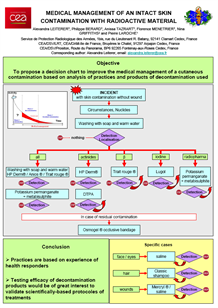External contamination is the deposition of a radionuclide on a person’s clothing, or directly on their skin or hair. Undressing allows removing most of the contamination, although decontamination is still necessary to remove as much of the remainder as possible from the skin, hair and nails. The purpose of decontamination is to remove the contaminant as quickly as possible from the skin, by washing with soap and water, and potentially followed by the application of decontaminating products. A control for residual radioactivity should be performed after each wash. Cleaning too aggressively should be avoided, so as not to weaken the natural protective barriers of the skin.
The predominantly used and recommended liquid decontaminants are soap, Fuller’s earth, potassium permanganate (KMnO4) associated with a reducer, Lugol’s iodine, Trait rouge® soap or diethylene triamine pentaacetic acid (DTPA), particularly for contamination by actinides (Pu, Am, U, etc.). However, many products currently on the market are not recommended by authorities or health safety agencies, as they frequently are not specific for contamination by radionuclides. Studies would be necessary to test their effectiveness and to explore their mode of action.
Skin decontamination is an essential step because it allows: reducing the dose received across the skin (either through a wound or more rarely through healthy skin); preventing the development of acute and delayed radiation-induced effects; and avoiding contamination of other people.
| 
| Medical management of an intact skin contamination with radioactive material, poster session of NBC 2012, 8th symposium on CBRNE threats (Turku, Finlande) |